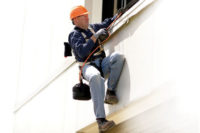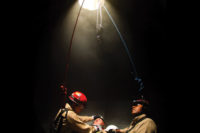Understanding and preparing for confined-space work & rescue

Confined spaces come in many shapes and sizes. They can be vertical or horizontal, and may be relatively small or quite large. In fact, the size of the space does not determine whether a work space qualifies as “confined space.” A confined space is defined by following characteristics:
- Large enough that a person can completely enter the space and work
- Is not designed for continuous occupancy
- Has a limited means of entering and exiting the space
If the space meets these characteristics, then it qualifies as a confined space regardless of its size.
The next question is whether the space is a “permit-required” (or “permitted”) confined space. In simplest terms, a space with a higher level of risk is generally going to require permits. That is, as outlined in OSHA 1910.146 regulation on Permit Required Confined Spaces, only workers carrying a permit may enter and/or work in that space. The OSHA guidelines specify that a confined space is permit-required if:
- It contains or has the potential for a hazardous atmosphere
- It contains or has the potential for an engulfment hazard
- It has the ability to trap a worker inside due to its internal configuration
- It contains or has the potential for any other hazard that could cause injury or death
- If none of these characteristics exist, then the space is a non-permit confined space.
Requirements for workers in confined spaces
Employees working in and around confined spaces must, of course, be properly trained. They also must have the proper personal protective equipment (PPE). OSHA defines three levels of workers in permitted confined spaces, each with its own training requirements. Employees entering the space to work must be trained as an Entrant. Those watching the Entrants should be trained as Attendants, and those overseeing the work should be trained as Supervisors.
The challenge of confined space rescue
With all of the inherent risk of working in confined spaces, the situation is even more hazardous in emergency rescue scenarios. In fact, more people have lost their lives performing confined-space rescues than those working in the spaces. Further, statistics show that over 60 percent of these fatalities resulted when the rescuers were not properly equipped or trained to perform confined-space rescue. These are the very reasons that OSHA 1910.146 was drafted, and this puts considerable importance on developing and maintaining a complete rescue plan for confined spaces.
One of the requirements for permit-required confined spaces is having a rescue team available. While it is not uncommon for employers to contract with external rescue service providers, it is not reasonable to assume you can simply call 911. Many fire departments and rescue squads are not adequately trained or equipped to perform confined space rescues, and cannot be relied on as a “standby rescue team.”
Another option is to equip and train your own in-house rescue team. This will require confined-space rescue training, a 40- to 60-hour class, and performing training annually. An in-house rescue team should also be evaluated as to their proficiency.
Equipping people for confined space
To determine the equipment necessary to handle confined space entries and rescue, you must consider the types of spaces you have. For instance, if your spaces are generally vertical, then some type of tripod or similar system would be required.
All spaces require a good Class III Harness. It should be easy to put on and comfortable to the one wearing it, with multiple attachment points. A helmet, gloves, boots and eye protection are all a must. Often a retrieval system of some sort will be needed. It should be rated for a minimum of a two-person load. If you are working in spaces that are elevated for entry, you may also need to consider fall protection.
Confined-space rescue is made all the more challenging when it’s at height, such as inside a wind tower or similar structure. The most difficult aspect of a rescue from elevation may be getting the injured worker down, which may require a lowering system that is easy to use and provides sufficient flexibility to be useful in a variety of scenarios.
Employers also need to look at devices for packaging and transport of the injured worker. Packaging with the LSP Half-Back extrication/lift harness is a good option, and you should also have a Stokes litter (a rescue basket-style stretcher). A flexible roll-up style litter (constructed of PVC or similar material) is also useful for use in confined spaces.
Preparation means training
Effective and frequent training of the rescue team ensures that rescues are performed quickly and efficiently. At the same time, when employees are trained in the proper procedures for working in confined spaces, and when they follow all guidelines and safety procedures, rescue is less likely to be needed.
If you maintain your own in-house rescue team, training should be done on a regular basis for both entry and non-entry rescue. The two most difficult aspects of confined space rescue are the physical task of packaging the patient and the mental aspect of simply going into a confined space. Simply put, not everyone is cut out to go in and perform a technical rescue in confined space. This should be determined during selection and training of your rescue team — it should not be discovered during an actual rescue operation.
A confined-space rescue can be one of the most challenging types of rescues to perform. Safety is the No. 1 consideration, so knowing the OSHA regulations and ensuring that people have the proper equipment and are trained for the task are extremely important.
Looking for a reprint of this article?
From high-res PDFs to custom plaques, order your copy today!






